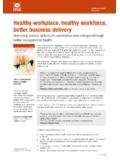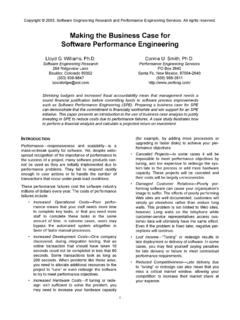Transcription of AML model risk management and validation - EY
1 AML model risk management and validation Who we are EY's Anti-Money Laundering (AML) and Regulatory Compliance Technology practice is a global team of client-serving, financial services professionals. Our team members come from a variety of financial services, regulatory and technology backgrounds. Together, we leverage years of experience and deep content knowledge to help our clients solve challenging problems in a demanding regulatory environment. What we do We help our clients as they work to fulfill their regulatory and Optimization and model validation compliance requirements by providing services to meet their Case management immediate needs and their long-term goals. Using a highly sophisticated and customizable tool set Specifically, we develop technology architecture and program specially developed by EY to address our clients' needs and road maps, gather business requirements, assist with vendor challenges, we help clients meet key objectives: selections, develop functionality specifications, and assist in B.
2 Rand and reputation protection by preventing disciplinary system implementation, testing and quality assurance. action and fines Our AML technology service offerings cover a broad range Sustainable frameworks that can adapt to dynamic of regulation and products, including: corporate policies and regulatory requirements T. echnology strategy Loss prevention against unauthorized financial transactions Know your customer (KYC)/enhanced due diligence (EDD) Elimination of redundancy in activities performed to manage risk and comply with multiple regulations and Watch list/sanctions standards Transaction monitoring 2. The trend across all aspects of AML. risk management is toward greater analysis and statistical validation of models and processes. As they increase their focus on analytics, regulatory bodies are involving analytics and statistics specialists more in their examinations and reviews.
3 AML model risk management and validation Today's Bank Secrecy Act/Anti-Money Laundering (BSA/AML) the financial economists, among several other functions, is to programs are becoming increasingly reliant on quantitative perform reviews of quantitative methods and provide advice models in detecting suspicious activity, measuring risk and to national bank examiners and to bankers on model validation supporting key business decisions that drive operational and model control processes. The team, whose official name efficiencies. A contributing factor to this trend is a regulatory is Compliance Risk Analysis Division, also known as CRAD, environment that has a greater focus than ever before on recruits PhD economists and statisticians with expertise in managing the risks associated with quantitative models. Over quantitative statistical and mathematical modeling within the the past few years, regulatory examination teams have added financial services sector.
4 Quantitative specialists, released supervisory guidance and With the inclusion of CRAD in AML examinations and the issued regulatory enforcement actions related to sound and release of OCC 2011-12, regulators are placing a much effective management of model risk specific to AML. greater emphasis on statistically valid processes and methods. In 2011, the Office of the Comptroller of the Currency (OCC) Enforcement actions issued over the past two years include jointly with the Board of Governors of the Federal Reserve language challenging whether banks are using statistically released a bulletin entitled Supervisory Guidance on model valid processes, controls and validation techniques. Risk management . The guidance, commonly referred to as As a result, financial institutions under the supervision of the OCC 2011-12 or FRB 11-7, describes the elements of a sound OCC and Federal Reserve are investing in their AML model risk program to effectively manage model risk.
5 The guidance has management and model validation programs, by incorporating a broad scope that includes multiple aspects of model risk them into their enterprise model risk management functions, management , expanding on existing guidance and industry and enhancing AML programs to be better aligned with experience. A key element of this and previous guidance is the regulatory expectations. While at many institutions the driving need for independent review and model validations. force behind these investments may be a shift in regulatory In addition to OCC 2011-12, the OCC added a team of financial expectations and focus, the outcome can be better decision- economists to more effectively address issues related to the making, continual improvement in operational efficiency and use of quantitative methods and models for bank compliance reduced risk of costly remediation.
6 Activities, including anti-money laundering. A primary role of AML model risk management and validation 1. What are models and where While this is the broad definition, institutions with established enterprise model risk management programs will have more are they in AML? specific definitions that have been accepted by regulators and are used to drive their model risk management and validation The first step in understanding the benefits of model processes and controls. risk management and validation is to understand what models are and where they exist in an AML program. A Where models exist within an AML program is in part driven simplified interpretation of the definition of a model found in by the exact definition of a model within your institution. Supervisory Guidance on model Risk management is the However, the broad definition of a model and elements of a use of mathematical techniques to provide an output that is sound model risk program will apply across most areas of an quantitative in nature.
7 AML program, including: The guidance goes on to state that a model consists of three Customer due diligence components: Customer risk rating An information input component, which may consist of Transaction monitoring quantitative data, qualitative data, expert judgment and assumptions Alert and case risk scoring A processing component, which applies the mathematical OFAC sanctions and watch list screening technique to transform the inputs into a quantitative Money laundering risk assessment estimate A reporting component that translates the quantitative estimate into useful business information that drives decision-making and downstream processes What is a model ? (1) A simplified definition of a model is the application of mathematical techniques to provide an output that is quantitative in nature (2) Supervisory Guidance on model Risk management refers to a model as a quantitative method, system or approach that applies statistical, economic, financial or mathematical theories, techniques and assumptions to process input data into quantitative estimates.
8 2. Figure 1: AML model risk management framework Governance, policies and controls 1. KYC models to identify EDD. requirements model validation 2. Methodology and Evaluation of Risk scoring models documentation conceptual soundness used to drive AML 1. Customer due diligence Ongoing monitoring monitoring processes 2. Customer risk rating Outcomes analysis 3. 3. Transaction monitoring Rules/scenarios 4. Alert and case risk scoring and methods for 5. OFAC sanctions and determining monitoring watch list screening system thresholds model 4. Configuration of scoring development, parameters based on implementation monitoring policies and risk areas and use 5. Models used to perform watch list matching and screening The added benefits of model risk internal auditors, or examiners. Decisions must be supported with well-documented rationale and evidence, and tracked management and validations to evaluate whether assumptions hold true initially and over time.
9 Managing decisions according to sound risk management While the evolving regulatory environment may be the practices, and validating those decisions over time, builds driving force behind many banks instituting improved risk confidence not only in examinations and audits but across management and validation around models, additional business lines and functions within the bank. For instance, a benefits beyond regulatory compliance can be achieved: single business line's well-documented processes based on Improved decision-making and confidence in models sound models, quantifiable benefits and ongoing validation Continuous improvement and enhancement procedures is likely to be adopted by other business lines, Reduced risk of remediation projects and look-backs jurisdictions or legal entities, as well as other key stakeholders, such as AML investigation teams and AML compliance.
10 Improved decision-making and confidence In addition, the results of validations may be used as key With the vast amounts of information available to decision factors in identifying and prioritizing projects. The validations makers, gut feel business decisions are not sufficient to satisfy will not only examine whether known limitations and AML model risk management and validation 3. assumptions are aligned with risk tolerances; they may also decisions, from how to allocate investigative, technical and identify trends as to where future risks lie. validation results analytics resources to how to prioritize programs competing also provide increased awareness of the impact of business for limited resources. decisions, both past and present. Reduced risk of remediation projects Continuous improvement and enhancement and look-backs model building techniques are inherently designed to maximize A main objective of a sound model risk management and effectiveness while reducing operational inefficiencies.
















